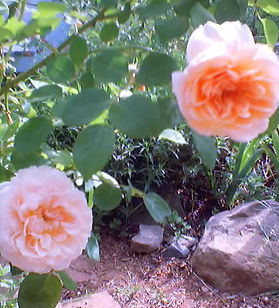

Propagation - Roses
We had been gardening for five years and, as all gardeners know, propagation is the wonderful transition every gardener makes, sooner or later. You have enjoyed planting seeds of flowering plants, snuggling in shrubs and ground covers, and planting roses. Now comes the time when you want more of what you have, you don't want to keep paying big bucks for them so you create them!
So this page is dedicated to us, some new gardeners, all aspiring plant propagators. The methods are simple, direct, and fun! Cloning plants is not only very feasible, but very satisfying. To take cuttings, or to take leaves of plants and coax them to grow and flourish, is the ultimate accomplishment. Planting your new 'babies' in the spring or fall, and watching them mature into wonderful creations is the highest reward! And creating "new" varieties is almost magical!
There are countless sites dedicated to plant propagation, and many personal websites that highlight personal gardens. Trust me, once you start visiting these sites, you will almost not want to leave your computer for the great outdoors! But then, you will certainly want to check on your beautiful, new plants in the garden, and ensure your current 'nursery' of cuttings is moist and happy!
My very first success with rose cuttings happened this summer. I took several cuttings of my Jane Austin rose in the early summer of 1997. I had only read about this and did not follow any technique, just took cuttings from an active branch, trimmed them, removing most of its leaves, and stuck it in sand where our makeshift 'nursery' was then located, placing it beneath a larger plant for shade, covered it with a little plastic bag for a couple of weeks, and kept it moist throughout the late summer. I protected it with mulch over the winter, and actually forgot about it as the bag had blown off. Then comes spring of 1998. A small bush with not many leaves emerged and I casually wondered what it was. I figured I would be able to tell later when it was larger. About mid-season, around the end of May of 1999, I was checking on the gardens, and stopped by this little nursery.
Most everything held in the nursery had been planted elsewhere, so the morning glories and strawberries had claimed this little sand pit. Wow, the little rose cutting had grown into a little shrub, all green and healthy! When I checked on it that June, she had her first bloom--a perfect Jane Austin rose, light peach and fragrant with a multitude of tight petals.
I shrieked in delight which brought my husband running! I absolutely could not believe it! She was perfect, gorgeous, and I had cloned her! Since then, she has four more buds ready to bloom and believe me, she is my most precious rose! If you always remember to just meet a plant's essential needs, it will do what it was meant to do--to live and grow abundantly in grace, beauty, and charm!
Usually, the rose cuttings that one is going to try to root are best taken from the stems of the rose bush that have just flowered and about to be deadheaded. Select long, strong, healthy stems from this season's growth, not old wood. The rose cutting should be 6 to 8 inches in length measuring down the stem from the base of the bloom. The rest of the leaves on the stem should be removed using the pruning shears or sharp scissors. Dip the lower portion of the cutting into a rooting hormone powder (Rooting hormone is optional). The planting medium most successful for rooting rose cuttings is a 50-50% blend of potting soil and perlite. This is a very light blend that encourages the roots to grow quickly.
Cover the stem with plastic: insert two eight-inch sticks or wires into the soil on either side of the stem to prop up the plastic or some use a mason jar, like grandma used to do... simply place a large mason jar over the stem. Covering the stem with glass or plastic will create a miniature greenhouse, and the cover will help keep in the heat, moisture, and ultraviolet rays the stem needs to root and grow. Keep the rose cuttings moist at all times, with good air circulation and sunlight. It takes approximately four to eight weeks for the cutting to take root and grow a new set of leaves. Your new rose should bloom in its second or third year. It's really that easy! Below is the cutting I took and grew of Jayne Austin, some 5 years later!
